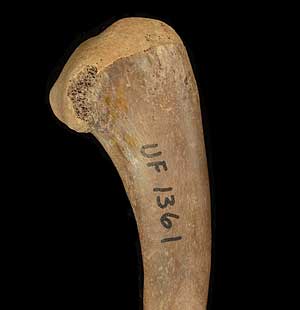The Division of Vertebrate Paleontology welcomes the use of its collections by outside researchers regardless of academic affiliation.
 The following steps should be taken:
The following steps should be taken:
- Contact one of the Vertebrate Paleontology curators and inform them of the intended dates of your visit and the type(s) of fossils you wish to study. This should be done at least two months in advance of your visit.
- If your work involves destructive sampling (e.g., radioisotopic dating; stable isotopic sampling of tooth enamel; REE sampling of bone, etc.), you must provide a detailed, written justification for the sampling, including a sound scientific rationale of why this is necessary for your project.
- Visitors can work in the collection from 9 AM to 5 PM, Monday through Friday. Special arrangements to work on weekends, state holidays, and in the evenings can be arranged on a case by case basis, if personnel are available to supervise you.
- Visitors must get written permission from a curator to conduct systematic research on fossils in the collection that will lead to the formal description of new species or other taxa. It is best if such arrangements are made beforehand, but if your work in the collection leads to the discovery of new taxa that you wish to publish or include in a thesis or dissertation, you should immediately contact the curator in charge of the collection to get permission to describe or formally name these taxa. Visitors should be aware that limits may be placed on their access to specimens currently being studied or described by others, and should inquire about potential conflicts before their visit.
- Visitors can study specimens that are on permanent display at our public exhibition facility, Powell Hall, but must provide museum staff with sufficient time to take the specimens off display. Research quality casts of many of the specimens are display are housed in the collections facility.
- Visitors wishing to use or measure comparative skeletons of modern animals must make separate, prior arrangements with the appropriate Florida Museum curator of ichthyology, herpetology, ornithology, or mammalogy.
- Visitors are welcome to borrow and use reprints, books, and journals stored in the Simpson Library of Paleontology during the course of their stay. These items must not leave Dickinson Hall. Photocopying or scanning is allowed as long as the physical condition of the item will permit it without damage.
- Visitors wishing to borrow specimens and hand carry them back to their institution must allow the collection manager sufficient time to prepare the loan paperwork and pack the specimens. Usually a day’s notice is sufficient, but more time may be needed if large numbers of specimens are involved.
- For the sake of security, the exact physical location of many of our fossil sites may not be published. If it is necessary for their research, visitors will be allowed to access the collections’ locality database, files, and maps. However, they should consult with the collection manager or a curator as to the level of precision they may publish locality information.
- Visiting researchers may publish photographic images or drawings they take or execute of fossil specimens in the Florida Museum Vertebrate Paleontology collection in technical research journals, monographs, and books, in semi-popular articles and popular books, and on Internet web sites. Such specimens must be identified by their catalogue number and the correct collection acronym (UF, UF/FGS, or UF/PB). Similarly, visitors can publish measurements of these specimens, as long as the catalogue number is listed. If visitors wish to work on specimens that are not catalogued, ask the collections manager to assign numbers to the specimens.
- Outside researchers must provide us with at least one copy of any published work that is based in part or in its entirety on specimens in the Florida Museum Vertebrate Paleontology collection. This copy will be accessioned into the Simpson Library of Paleontology. Two copies are required for works in which new taxa are formally named. If no physical reprints are available, a copy of a high quality computer file in PDF format is an acceptable substitute.
Dickinson Hall’s Location
The Florida Museum Vertebrate Paleontology collections are housed in the second floor, east wing of Dickinson Hall on the University of Florida campus. Dickinson Hall is located on the southwest corner of the intersection of Museum Road and Newell Drive. Visitors should enter the front, street-level doors off of Museum Road, and sign in at the receptionist’s deck. At this time they should obtain a name badge that must be worn at all times while in the building. The receptionist will page the collection and arrange for someone to open doors and guide the visitor to the collection.
Parking on the University of Florida campus can be challenging, especially on weekdays during the Fall and Spring semesters (mid August through early May). Visitors can get a temporary parking permit at the campus police station located due east of Dickinson Hall on the southeast corner of the intersection of Museum Road and Newell Drive. But note that just having a permit does not guarantee you a place to park. Another option for visitors is to use the parking garage two blocks west of Dickinson Hall in the University Welcome Center and Student Union on Museum Road. There is a fee to park in this garage. Visiting researchers should if at all possible avoid campus on days in the fall with home football games or on other days with large public events, such as Spring graduation.